The Mechanics Behind Underwater Drones
At the heart of these devices lies sophisticated engineering. Equipped with cameras and sensors, drones navigate the ocean depths, capturing images and data that once required human divers to attain. This innovation minimizes the risk to human life and allows access to previously unreachable locations. These drones leverage sonar technology, GPS, and AI algorithms to map the seabed, monitor marine habitats, and even detect underwater anomalies.
Applications and Innovations

From academic research to tourism, underwater drones offer diverse applications. Universities employ them for environmental studies, enabling researchers to gather vital information on ocean health and biodiversity. Documentarians use drones to capture breathtaking footage, bringing audiences face-to-face with marine creatures in their natural habitats. Recreational users explore coral reefs or observe schools of fish without disturbing the delicate environment.
Recent advancements have led to more durable designs, capable of withstanding high pressure and harsh underwater conditions.
How Drones Are Transforming Underwater Exploration
Historically, our knowledge of underwater worlds was limited by depth and accessibility. However, drones have transformed this pursuit. Now, drones routinely operate at depths exceeding 100 meters, braving the cold and dark to shed light on unique marine formations. This capability leads to fascinations with underwater volcanoes, shipwrecks, and marine archaeology.
Moreover, drones are employed in conservation efforts, tracking endangered species and monitoring illegal fishing activities. Their silent operation makes them ideal for observing aquatic life without disruption, providing genuine insights that fuel preservation strategies. Scientists have documented shifts in marine ecosystems, attributing much of this knowledge to drone data.
Challenges and Opportunities
Despite their advantages, underwater drones face challenges, including navigation in strong currents and avoiding obstacles like marine creatures or debris. Engineers continuously work to refine drone software, enhancing their adaptability in unpredictable conditions. The future holds promising opportunities for drone technology to integrate with other innovations such as satellite imagery, offering even broader oceanic research tools.